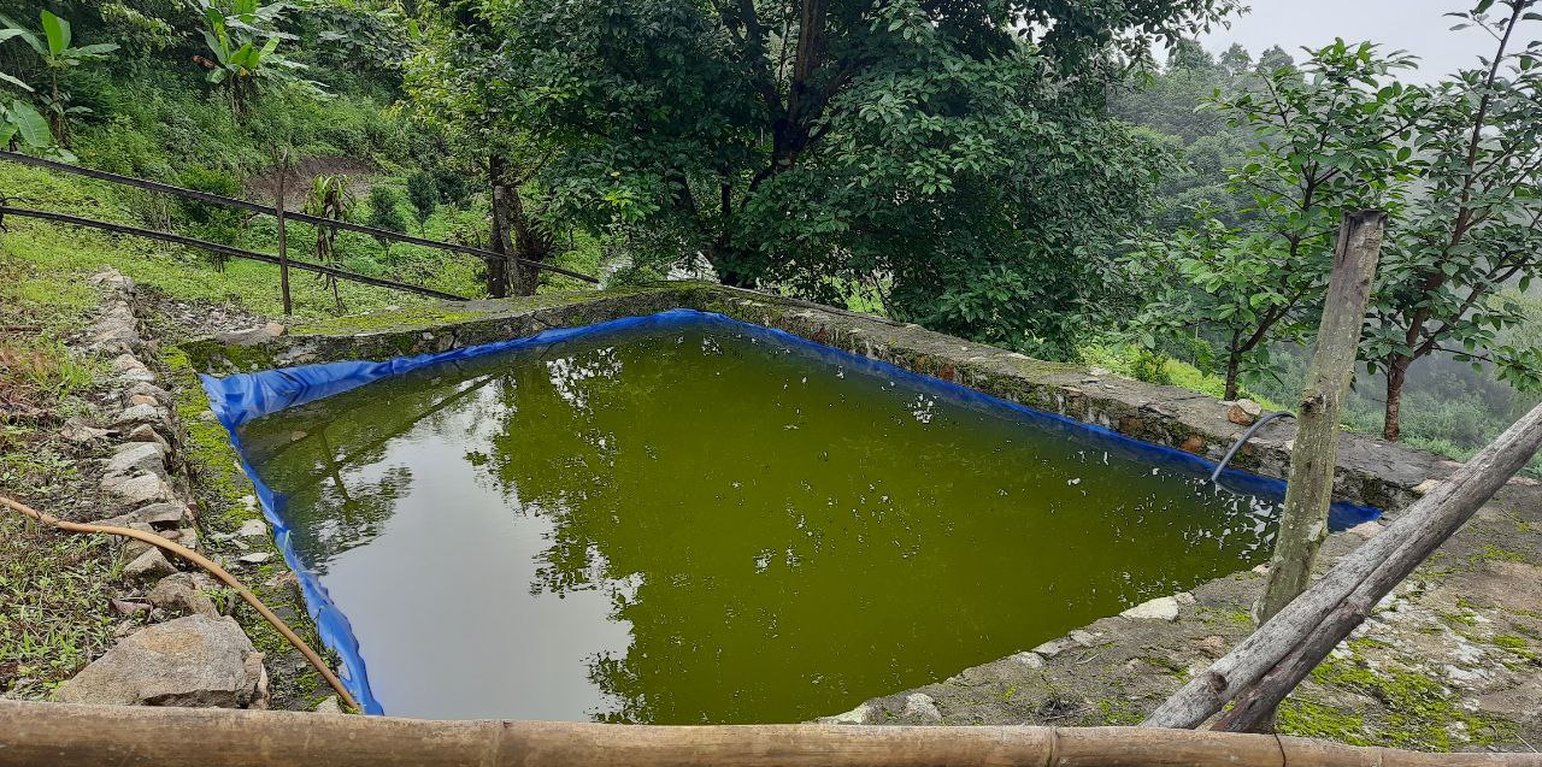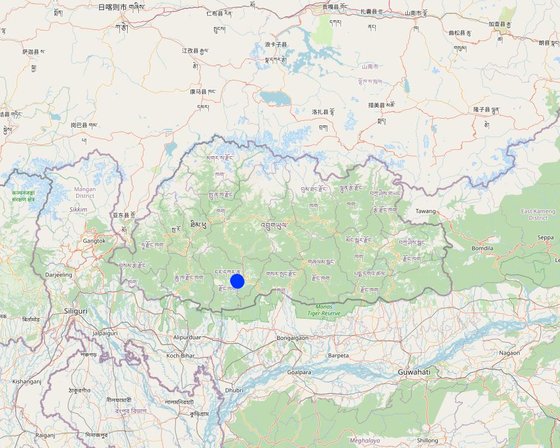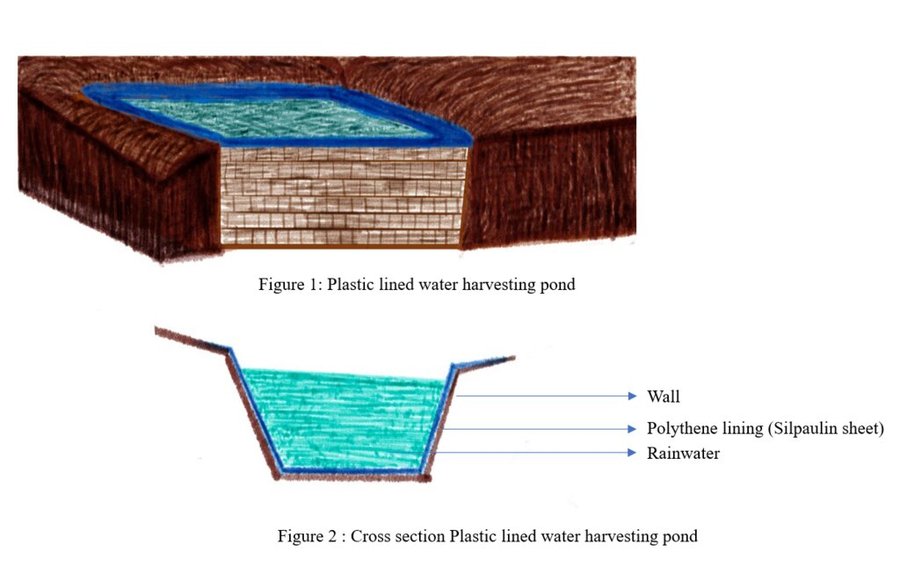



Low-cost plastic-lined water harvesting pond are used to collect and store rain or overland flow water for agricultural purposes in the dry season. They are economic and efficient. These ponds are required in the context of irrigation water shortages. Although rainfall has been projected to be increasing (NCHM, 2017), irrigation water shortage was - and continues to be - one of the major constraints in crop production (IHPP, 2017).
Water from precipitation and surface water sources is lost due to inadequate collection and storage. Villages at the top of the hills, in particular, suffer from acute irrigation as well as drinking water shortages. To tap and collect wastewater, rainwater, and water from other perennial and non-perennial sources, low-cost plastic lined water harvesting ponds are proposed. This water can be used during the dry or “lean” season for agricultural as well as household purposes.
The proposed model pond (plastic sheet size; 9m * 7m) costs less than Nu. 25, 000 (USD 315) for construction but can hold more than 27, 000 litre of water. The same dimension of pond if constructed using concrete, would cost more than Nu. 1, 19, 000 (USD 1500). Furthermore a 10, 000 litre synthetic tank available on the market costs more than Nu.35, 000.
Irrigation water shortage results in fallow lands. It is reported that 6,400 acres (2,600 ha) of irrigable land was left fallow in 2016 and 26 % of the total households surveyed were affected by irrigation water shortages (DoA, 2016). By reducing fallow land and increasing crop production, this technology could be a stepping stone towards food self-sufficiency – as well as providing water for consumption by people and livestock.
Though a similar technology is said to have introduced in the country many years ago, the present form of the technology was introduced to Barshong gewog in Tsirang Dzongkhag by the ‘Himalica’ pilot project in 2014. However, the proposed technology has been modified and improved to suit to the topography and needs of farmers in Bhutan. The proposed pond design is a reverse truncated square pyramid shape unlike the cuboid shape ponds of ICIMOD’s. The pond is designed in such way as to increase pond stability and ease of construction.
Concrete tanks require specific construction methods and faults can develop with ice freezing and expanding in cracks in tank walls during the winter (Slater, 2011). Plastic (silpaulin) sheet lined ponds are leak-proof and primarily depend on the longevity of the plastic sheet unlike concrete tanks. Concrete water tanks, (especially elevated tanks) are also prone to damage due seismic activities (Housner, 1963).
The low-cost plastic lined water harvesting pond adopted is cheap, environmentally friendly, and has positive social impacts. It reduces irrigation water constraints, addresses fallow land problems, and supplements water for domestic purposes. The technology is a tool for reducing poverty, expanding cultivated land and increasing food self-sufficiency resulting in a healthier and happier society.

地点: Pangserpo Chiwog, Drujeygang Gewog, Dagana Dzongkhag, 不丹
分析的技术场所数量: 单一场所
技术传播: 适用于特定场所/集中在较小区域
在永久保护区?: 否
实施日期: 2019
介绍类型





| 对投入进行具体说明 | 单位 | 数量 | 单位成本 (Ngultrum (Nu.)) | 每项投入的总成本 (Ngultrum (Nu.)) | 土地使用者承担的成本% |
| 劳动力 | |||||
| Construction of pond | Person-days | 8.0 | 500.0 | 4000.0 | 100.0 |
| 施工材料 | |||||
| HDPE pipe | Metre | 100.0 | 40.0 | 4000.0 | 100.0 |
| Wire mesh | Pieces | 2.0 | 3500.0 | 7000.0 | |
| Silpaulin plastic sheet | Pieces | 1.0 | 7500.0 | 7500.0 | |
| Wooden post | Pieces | 14.0 | 60.0 | 840.0 | 100.0 |
| 技术建立所需总成本 | 23'340.0 | ||||
| 技术建立总成本,美元 | 291.75 | ||||
| 对投入进行具体说明 | 单位 | 数量 | 单位成本 (Ngultrum (Nu.)) | 每项投入的总成本 (Ngultrum (Nu.)) | 土地使用者承担的成本% |
| 劳动力 | |||||
| Reconstruction of pond | Person-days | 15.0 | 500.0 | 7500.0 | |
| 施工材料 | |||||
| Cement (50 kg per bag) | Bag | 10.0 | 400.0 | 4000.0 | |
| 技术维护所需总成本 | 11'500.0 | ||||
| 技术维护总成本,美元 | 143.75 | ||||
The land users mentioned that there has been an increase in production due to the availability of irrigation water during the dry season.
Improved irrigation water leads to better quality of crops. For example, the leafy vegetables will be flaccid with a reduced total leaf area in the absence of irrigation.
The availability of water during the critical periods of crop development in dry seasons reduces the risk of production failure.
The harvested and stored water from the tank is used to feed the livestock. It is also used to maintain the sanitation of the cattle shed.
The spring water dries in the winter. Therefore, the stored water in the water harvesting tank is available during dry seasons for irrigation.
Trapping the rainwater prevents the utilization of scarce spring water. Therefore, reducing the demand for irrigation from the spring water source.
Irrigation plays a significant role in crop cultivation. Therefore, with adequate irrigation water crop production and productivity increase leading to increased farm income.
With sustainable sources of irrigation, land users produce enough food for self-consumption increasing food security. Further, the land users sell the produce and generate income with which they can purchase nutritious foods that are not available on the farm.
Water is important to keep the surroundings clean. Therefore, the technology improves the health of the farm household and livestock.
Using drinking water for irrigation leads to social conflict. However, the issue is resolved with the low-cost plastic-lined water harvesting technology.
The amount of water available for farm activities is increased as the technology traps overflow and rainwater preventing water wastage.
The rainwater and overflow water are harvested efficiently preventing runoff and surface erosion.
Water harvesting pond acts as a suitable habitat for mosquitoes therefore increasing the risk of malaria.
The impact of drought on agricultural activity is significantly reduced as the tank increases water availability.
Reduced spring water requirement in the field is diverted to water availability for other farming communities and wildlife.